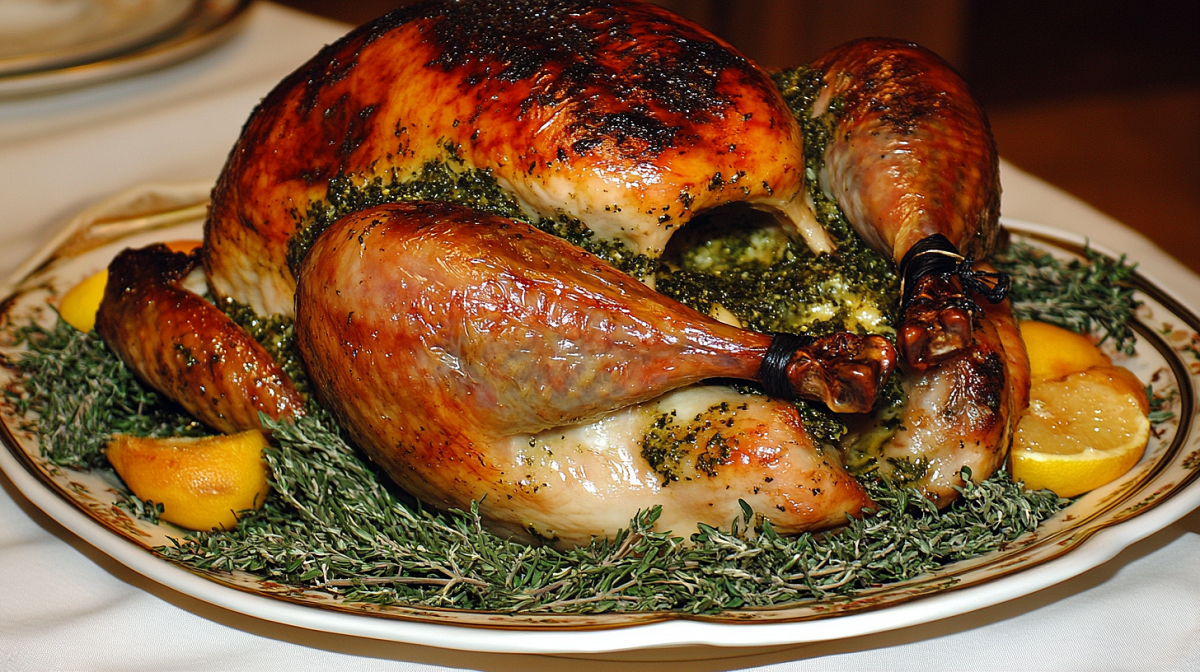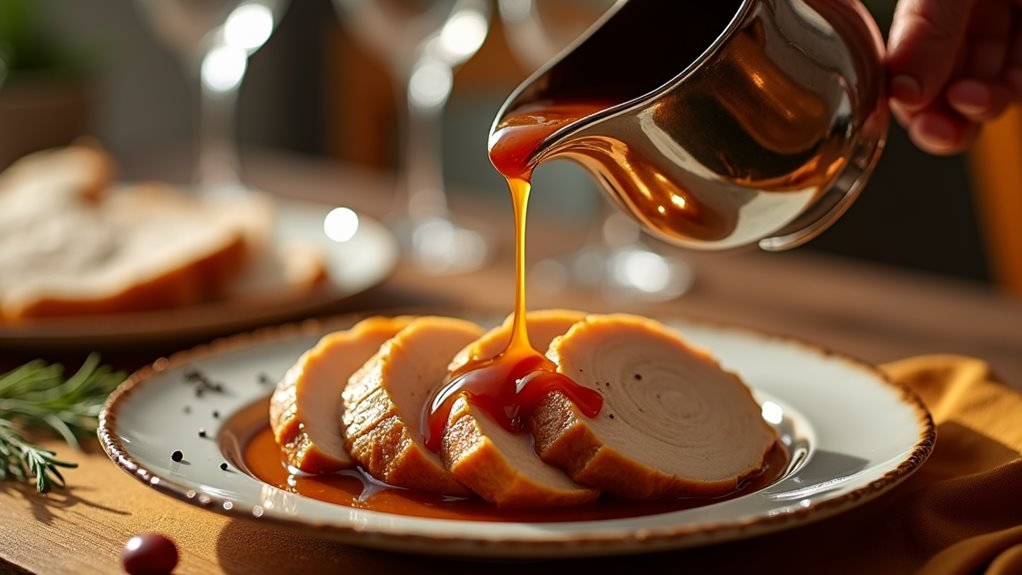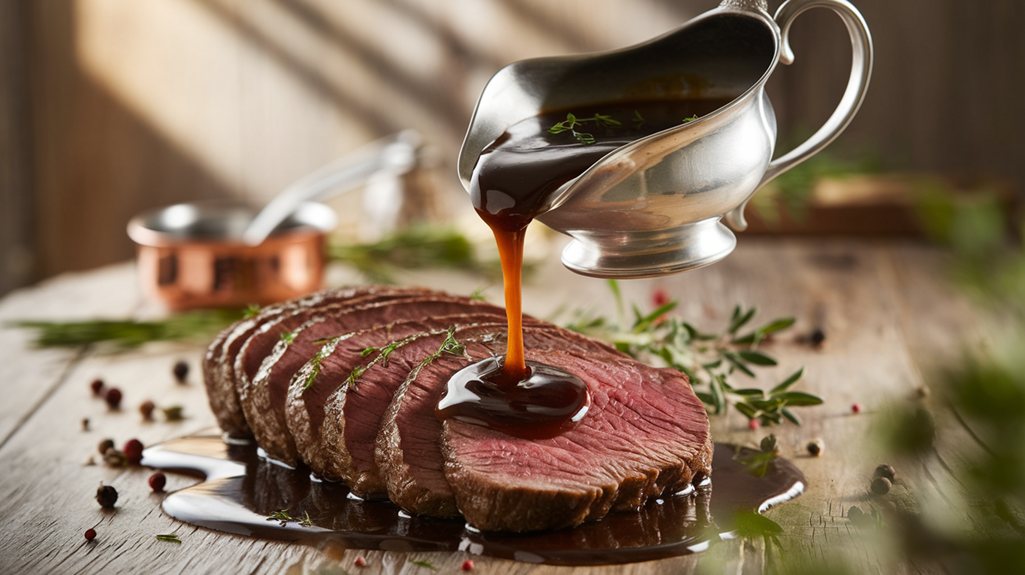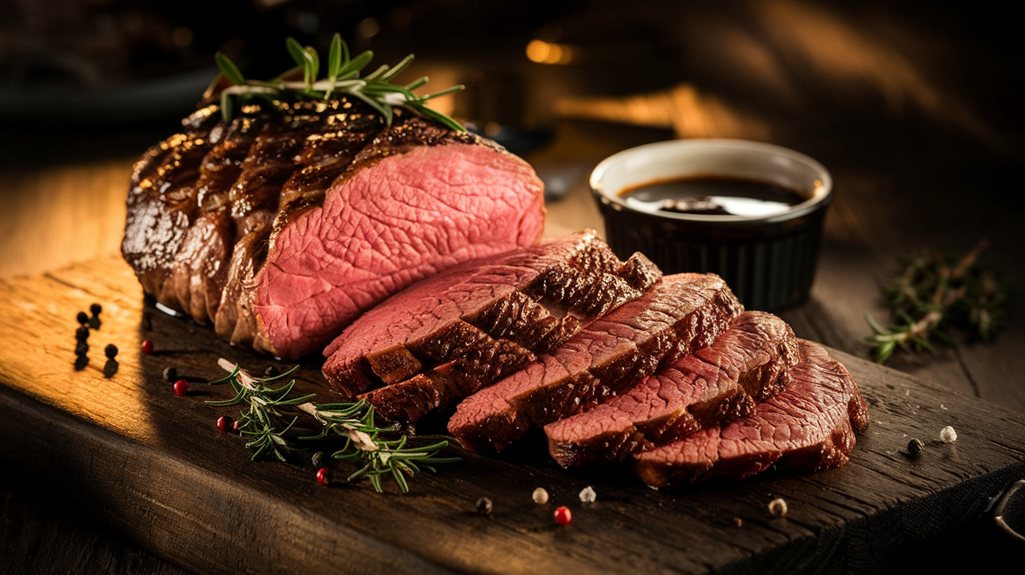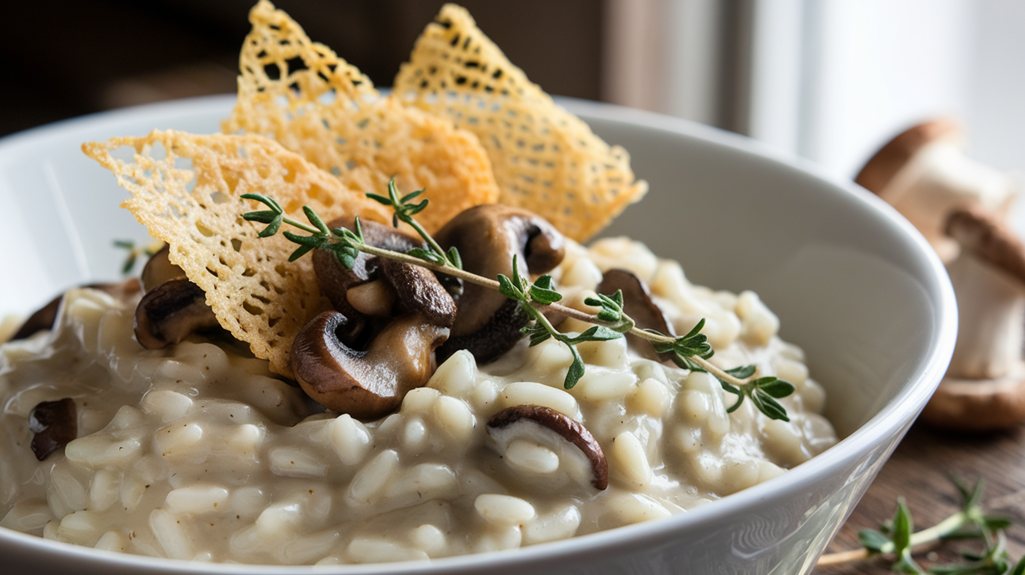If you’re searching for a foolproof way to make your Thanksgiving turkey stand out, Gordon Ramsay‘s herb butter method offers a compelling solution. You’ll explore how this world-renowned chef combines classic techniques with his signature flair to create a centerpiece that’s both impressive and achievable. His approach transforms an often-dry holiday bird into a succulent masterpiece, complete with crispy skin and perfectly seasoned meat. While the recipe might seem straightforward, there’s more to this method than meets the eye, and the results will transform how you approach turkey preparation forever.
Summary and Insights
- Mix softened butter with fresh sage, thyme, sea salt, and pepper to create a flavorful herb butter compound.
- Create pockets between the turkey skin and meat, then generously apply herb butter mixture underneath and on top.
- Start roasting at 425°F for 30 minutes to achieve crispy skin, then reduce to 350°F for the remaining cooking time.
- Baste the turkey every 30 minutes with pan drippings to maintain moisture and enhance flavor development.
- Let turkey rest for a minimum of 30 minutes after reaching 165°F internal temperature before carving for optimal juiciness.
History
Gordon Ramsay’s herb-butter turkey recipe emerged from centuries of British and American roasting traditions. It blends classic techniques with his signature focus on simplicity and flavor. The method draws from the 18th-century European practice of using butter to baste poultry, which is documented in numerous historical cookbooks.
You’ll notice that Ramsay’s technique of placing herbs under the skin isn’t entirely new – it’s a refinement of a method that gained popularity in the 1960s when Julia Child introduced French cooking techniques to American homes.
However, Ramsay’s specific combination of fresh sage and thyme, along with his precise temperature adjustments, represents a modern evolution of these time-tested approaches.
The recipe’s development also reflects the growing trend of the 1990s and early 2000s, when professional chefs began simplifying complex restaurant techniques for home cooks. You’ll see this influence in Ramsay’s straightforward instructions and his focus on crucial ingredients. His method has since become a standard in contemporary cooking, inspiring countless home chefs to adopt this refined approach to the traditional Thanksgiving centerpiece.
His no-nonsense teaching style helps home cooks master essential techniques while building confidence in the kitchen.
Recipe
This classic Thanksgiving turkey recipe combines fresh herbs and butter to create a perfectly moist and flavorful centerpiece for your holiday table. The simplicity of the ingredients allows the turkey’s natural flavor to shine while achieving a golden-brown, crispy skin that will impress your guests.
The key to success lies in the herb-infused butter mixture, which is carefully worked under and over the skin before roasting. This technique guarantees the breast meat stays juicy while the skin develops a beautiful crisp texture during the cooking process. The result is a perfectly cooked turkey with herb-flavored meat and a stunning presentation. Similar to the crispy fish batter, achieving the perfect golden-brown exterior requires careful attention to temperature and timing.
- 12-14 pound whole turkey, thawed
- 1 cup (2 sticks) unsalted butter, softened
- 1/4 cup fresh sage leaves
- 1/4 cup fresh thyme leaves
- 2 tablespoons sea salt
- 2 teaspoons black pepper
Remove turkey from refrigerator 1-2 hours before cooking and pat dry with paper towels. Mix softened butter with finely chopped herbs, salt, and pepper. Carefully separate the skin from the meat using your fingers and massage the herb butter mixture both under and over the skin. Tie legs together and tuck wing tips under. Place in a roasting pan and cook at 425°F for 30 minutes, then reduce temperature to 350°F. Continue cooking for 2-2.5 hours, basting every 30 minutes until internal temperature reaches 165°F in the thickest part of the thigh.
For best outcomes, make sure the turkey is completely thawed before starting preparation. If skin browns too quickly, cover loosely with aluminum foil. Always let the turkey rest for at least 30 minutes after cooking before carving to allow juices to redistribute throughout the meat. Reserve pan drippings for gravy, and keep in mind that frequent basting is crucial for even browning and maintaining moisture throughout the cooking process.
Cooking Steps
You’ll begin overheating your oven to 425°F while preparing a flavorful herb butter mixture with softened butter, sage, and thyme.
Next, you’ll need to thoroughly pat your turkey dry and carefully separate the skin from the meat to massage the herb butter mixture both under and over the skin.
Once your turkey’s prepared, you’ll roast it at 425°F for 30 minutes, then reduce the temperature to 350°F, continuing to cook and baste every 30 minutes until the internal temperature reaches 165°F in the thickest part of the thighOvenep 1. Preheat oven to 425°FOvenreheating the oven correctly marks the fundamental initial step in achieving the perfect Thanksgiving turkey. You’ll want to set your oven temperature to precisely 425°F and allow it to reach this temperature fully before introducing your turkey, which typically takes 15-20 minutes in most modern ovens. This initial high temperature is vital for creating that golden-brown, crispy skin that Gordon Ramsay’s recipe is known for.
While your oven preheats, it’s ideal to confirm that your roasting pan is properly positioned on the lower third tier, allowing adequate space for the turkey while maintaining ideal heat circulation.
If you’re using a convection oven, you’ll want to decrease the temperature by 25 degrees to 400°F to compensate for the more efficient heat distribution. Keep in mind that a properly preheated oven is non-negotiable – placing your turkey in an oven that hasn’t reached the correct temperature will affect both cooking time and the final result. Oven’ll know your oven is ready when it maintains a steady temperature for at least 5 minutes after reaching 425°F.
Step 2. Prepare Herb Butter Mixture
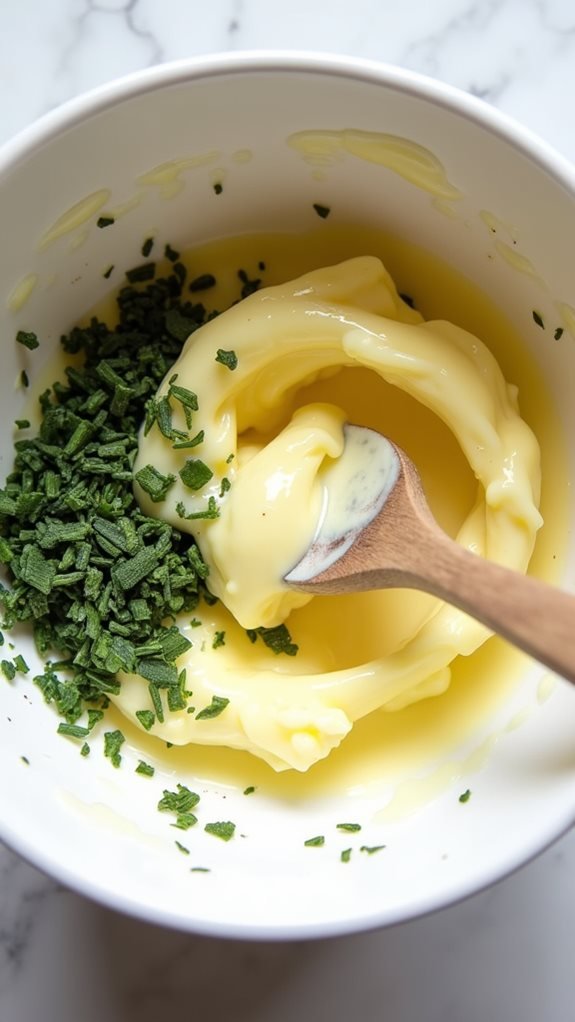
Mastering the herb butter mixture is a crucial step in Gordon Ramsay’s turkey recipe. You’ll need to start with two sticks of high-quality unsalted butter that have been softened to room temperature, ensuring they’re pliable enough to blend smoothly with the herbs.
In a medium bowl, combine the butter with finely chopped fresh sage and thyme, creating an aromatic blend that’ll infuse your turkey with rich, seasonal flavors.
Add two teaspoons of sea salt and one teaspoon of freshly ground black pepper to your butter mixture, incorporating them thoroughly until well combined. Work the ingredients together using a rubber spatula or wooden spoon until they’re completely integrated, ensuring there aren’t any streaks of plain butter remaining.
The final texture should be smooth and easily spreadable, making it perfect for both under-skin application and exterior basting. If your butter mixture feels too soft, you can refrigerate it for 5-10 minutes, but don’t let it harden completely – it needs to remain spreadable for proper application on your turkey.
Step 3. Pat Turkey Until Dry
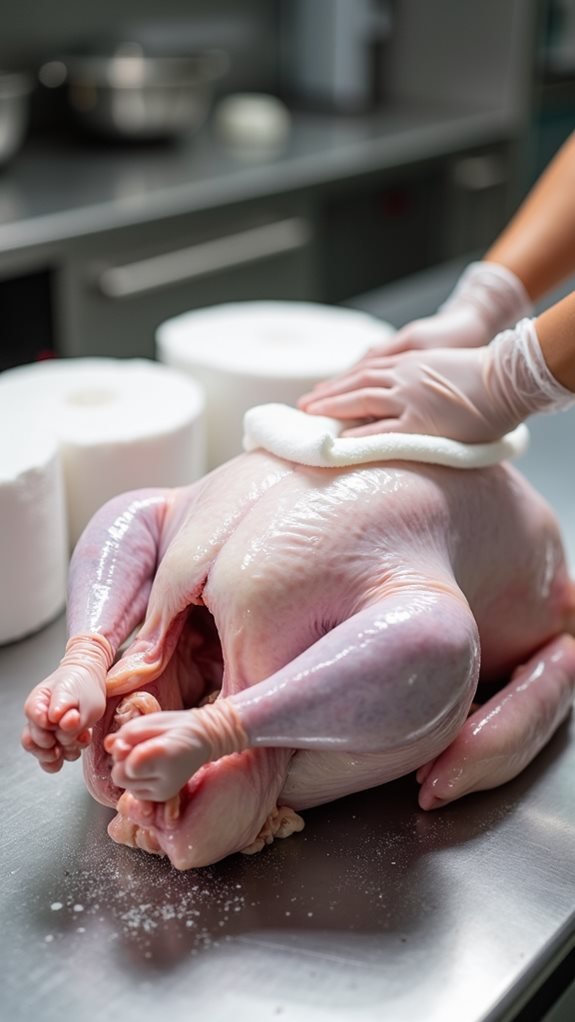
With your herb butter mixture ready, the next key step is properly drying the turkey. Remove the turkey from its packaging and discard any giblets or neck pieces from the cavity. Then, using paper towels, thoroughly pat the bird dry, paying special attention to both the exterior and interior surfaces.
Don’t rush this important step, as excess moisture will prevent your turkey’s skin from achieving that desired golden-brown crispiness. Work methodically, replacing saturated paper towels with fresh ones until the bird is completely dry. Once you’ve finished, let your turkey sit at room temperature for an hour, which allows for more even cooking and better butter absorption.
During this time, you can position your oven rack in the lower thiOvenection of the oven and begin preheating to 425°F. While you wait, inspect your turkey one final time to make sure no moisture has accumulated. If you notice any damp spots, give them a quick pat with fresh paper towels. This attention to drying will greatly impact your final results, creating the perfect base for your herb butter application.
Step 4. Apply Butter Under the Skin

Carefully separating the turkey skin from the meat marks one of the most pivotal steps in achieving a perfectly moist bird. You’ll want to begin at the breast area, gently sliding your fingers between the skin and meat to create a pocket while being cautious not to tear the skin. Work slowly and methodically, extending the separation down to the thighs and legs.
Once you’ve created these pockets, it’s time to apply the herb butter mixture. Take generous portions of your softened herb butter and gently massage it under the skin, ensuring even distribution throughout the separated areas.
You’ll want to work the butter into every accessible space, paying special attention to the breast meat, which tends to dry out primarily. As you apply the butter, you’ll notice the skin beginning to take on a slightly lifted appearance – that’s precisely what you’re looking for.
After you’ve placed butter under the skin, remember to coat the exterior as well. This dual-butter application guarantees that your turkey will self-baste as it cooks, resulting in tender and juicy meat while developing that sought-after golden-brown exterior.
Step 5. Roast and Monitor Temperature
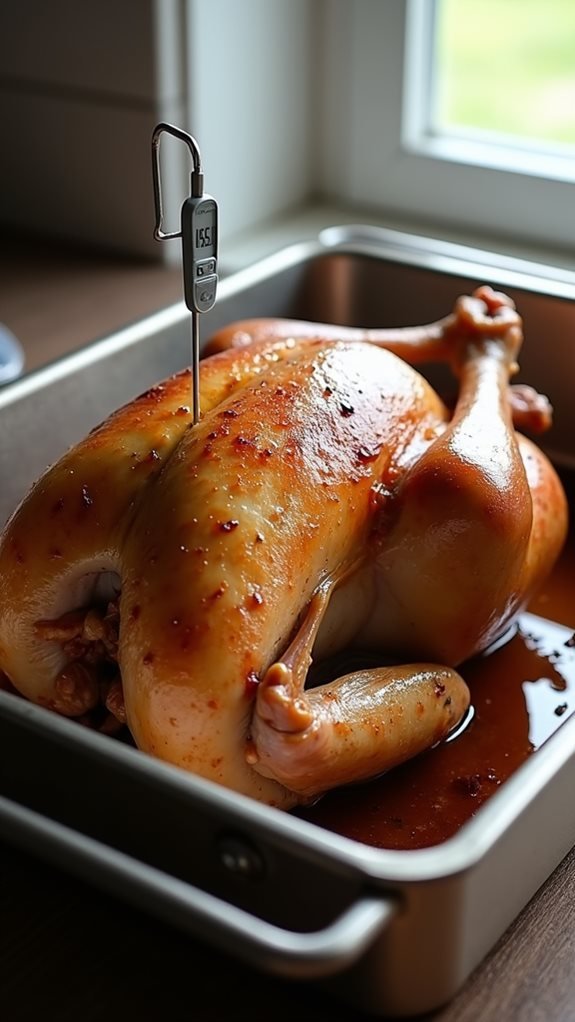
After preparing your turkey with herb butter, your next focus should be proper roasting technique and temperature monitoring. Place your turkey in a preheated 425°F oven, allowing it to roast at this higher temperature for the initial 30 minutes to achieve that golden-brown skin.
Then, reduce the temperature to 350°F for the remainder of the cooking process.
You’ll want to baste your turkey every 30 minutes with the pan drippings, ensuring even browning and maintaining moisture throughout. Insert a meat thermometer into the thickest part of the thigh, avoiding contact with bone, and monitor until it reaches 165°F. For a 12-14 pound turkey, you can expect total cooking time to be approximately 2.5-3 hours.
If you notice the skin browning too quickly, loosely cover the turkey with aluminum foil to prevent burning while allowing the meat to cook thoroughly. Once your turkey reaches the target temperature, remove it from the oven and let it rest for at least 30 minutes before carving.
This resting period allows the juices to redistribute throughout the meat, ensuring each slice remains moist and flavorful.
Common Questions About This Recipe
Many home cooks have questions about preparing Gordon Ramsay’s herb butter turkey, particularly regarding timing, temperature, and technique. Most concerns revolve around achieving the perfect golden-brown skin while maintaining juicy meat throughout the cooking process.
One common question is whether you can make the herb butter mixture in advance. Yes, you can prepare it up to 24 hours ahead and store it in the refrigerator, but you’ll need to allow it to soften before applying.
Another frequent concern involves the changing of the cooking temperature from 425°F to 350°F. This two-temperature method guarantees proper browning while preventing the meat from drying out.
If you’re curious about how often to baste, stick to the 30-minute schedule. More frequent basting can actually prolong cooking time by releasing too much heat from the oven.
To achieve crispy skin, the key lies in thoroughly drying the turkey before applying the herb butter and making sure your oven is fully preheated. Remember, if you’re working with a larger or smaller turkey, you’ll need to adjust cooking times accordingly, using the internal temperature as your ultimate guide.
Final Thoughts and Serving Ideas
Gordon Ramsay’s herb butter turkey deserves a presentation that matches its exceptional flavor and golden-brown exterior. You’ll want to place the beautifully roasted bird on a large, warmed platter, surrounded by fresh herb sprigs and seasonal garnishes like roasted citrus slices or small pears. Consider adding some roasted root vegetables around the base to create visual interest and provide ready-to-serve accompaniments.
For the most impressive carving experience, you’ll need a sharp carving knife and a sturdy meat fork. Start by removing the legs at the joint, then slice the breast meat against the grain in even portions. Arrange these slices in a fan pattern on your serving platter, making sure to include both white and dark meat options for your guests.
Don’t forget to serve the turkey with its natural pan juices or your homemade gravy in a warmed gravy boat nearby. A selection of traditional sides, like cranberry sauce, stuffing, and roasted vegetables, should be arranged in separate serving dishes around your main platter, creating an organized and appetizing holiday spread.
